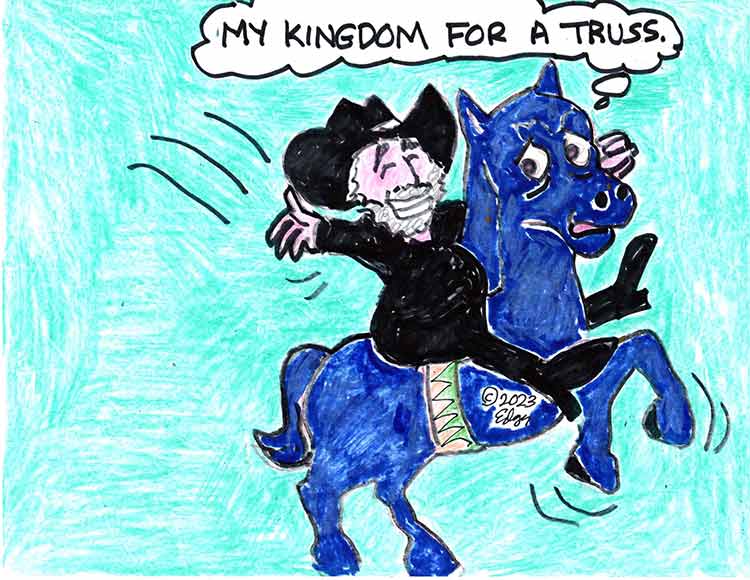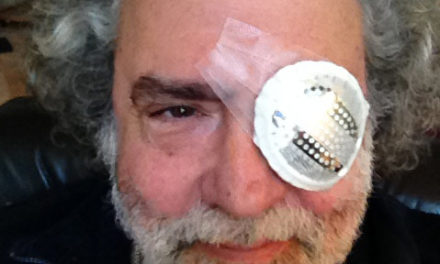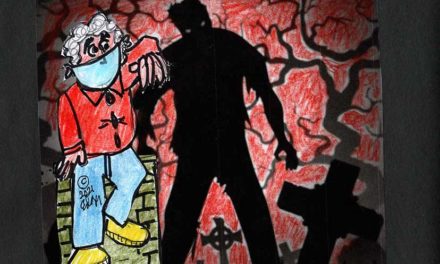The Time I Went Thataway
Or, How the West Was Undone
By Ed Goldman
FADE IN: Among the weirder tales of my young-adult years in Southern California is the time I “doubled” (did a stunt) for an actor. He’d died before he could complete a scene of him jumping out of a barn onto a horse then galloping away, a posse in hot pursuit.
Footage of the posse had already been shot and the director had also managed to film the capture of the bad guy, shortly before he died—both on- and off-camera. (For Hollywood conspiracy theorists, he died of natural causes when the free-based cocaine in his veins and bottle of Courvoisier in his digestive system caused him to die. Naturally.)
Sure to Sleigh the Critics
Exactly why it was necessary to show the actor’s acrobatic escape from the barn was beyond me. But the director, whom you’ll meet in a moment, kept mumbling something about “the sanctity of continuity” in his films, which were usually on the bottom half of a bill with movies like “Creature from the Vegetable Cooler” and “Half-Clad Coeds in Isolated Cabins.”
This was in 1974 or ‘75, and I had gone to interview that director, a former stuntman and occasional actor named Johnny Carpenter. He was then a battered 60 or so and he both lived and made his grade-Z westerns at his Heaven on Earth Ranch. The spread was situated in Lake View Terrace, which sits in a section of the San Fernando Valley that’s perhaps the hottest, stickiest and most welcoming to blood-sucking insects in all of SoCal.
“It may not look like much, this dusty little acre that’s a hubcap toss from the Foothill Freeway,” the Los Angeles Times wrote in 1995 when Carpenter was 80. “But for some, the Heaven on Earth Ranch is a unique place. It’s where many disabled children and adults touch a horse, take their first carriage ride and listen to stories about the Old West. The ranch’s proprietor, retired stuntman and actor Johnny Carpenter, works here almost daily, keeping it up for those who visit. ‘They get to play around here like puppy dogs and just have a good time,’ said Carpenter, 80.”
I was there to interview Carpenter for a short-lived all-cowboys/all-the-time magazine published by the equally short-lived Mies-Reed Productions. As that L.A. Times story indicated two decades later, Johnny was a helluva sweet man. But as I was interviewing him he kept looking me over head to toe, and for a quicksilver moment I wondered if he was a very myopic predator. So when he asked me how tall I was, I snapped, “What’s this about?” That’s when he told me about the actor’s untimely death before he could be filmed leaping out of the top floor of a barn onto his horse and riding hellbent for leather into the dust. (“Hellbent for leather” is what they say in cowboy movies. Podnuh.)
He asked me if I’d ever ridden a horse, which I had, and if I’d ever jumped onto one from two stories up, which I hadn’t. Not only hadn’t but had also never felt as though I should. “I’ll pay you!” he said. No dice. “We’ll do it in one take!” Blah-blah. “I’ll operate the camera myself!” Who cares? “You’ll be able to put on your résumé that you were in a Hollywood western!”
And that’s how he got me. A short while later I put on the late actor’s all-black cowboy outfit, which was a bit snug and long on me. “No one will be able to tell!” the director assured me. “Unless they’re not blind,” I thought but didn’t say. It would have sounded disrespectful and tasteless on so many levels.
Johnny realized that a novice stuntman wasn’t likely to be able to land on a horse from what looked increasingly to me like a great height. So he said we’d still try to do it in one take but that he’d hide a little trampoline behind the horse so I could just jump into that, feet first, and with the little bounce it would give me, pop up onto the horse.
That horse was wearing a beautiful saddle and I immediately realized this would now require the little trampoline to pop me high enough to clear the cantle, the raised back of the saddle. (I think the root of the word “cantle” is “can’t”. Or should be.)
I also wondered if moviegoers would accept the fact that after jumping onto the ground from two stories up wearing high-heeled boots, a guy could still have enough energy to propel himself, jump-shot-style, onto a horse’s back. I think this would have strained credulity for anyone who didn’t personally know Gerald McBoing-Boing.
This tale has a semi-happy Hollywood ending. Johnny really did get the whole thing in one take, I somehow didn’t break my pelvis—and the horse, perhaps indignant at having been jumped on so clumsily, took off on cue. Somehow I managed to keep the hat on my head, my hands on the reins and myself in the saddle.
Years later I caught the movie on Encore’s Western Channel very late one night. (It had “sagebrush” in the title, as I recall.) I watched with intense interest the actor playing the bad guy, knowing he was facing death both in the film and on the planet. And I was startled to realize I looked nothing like him, even at a distance when my stunt played out. He was at least six-three, weighed less than 160 pounds and had long, stringy black hair. I was barely six feet tall, weighed about 190 and had very curly hair (though also black; this was soooo long ago). Even if you squinted, you could tell I wasn’t him.
On the other hand, I couldn’t really tell it was me, either. Which made me wonder if this was a little game that Johnny Carpenter played with or on any guy coming to interview him, to provide himself with an upper hand. Who’s going to attack a man in print who made you a dangerous desperado for a few minutes?
In other words, had I, the designated stuntman for the dead actor, also had a stuntman, I wonder, as the camera slowly zooms away from our eternally perplexed columnist and we FADE TO BLACK. Run closing credits.
Ed Goldman's column appears almost every Monday, Wednesday and Friday. A former daily columnist for the Sacramento Business Journal, as well as monthly columnist for Sacramento Magazine and Comstock’s Business Magazine, he’s the author of five books, two plays and one musical (so far).
Yes, Virginia
A Weekly Blog by Virginia Varela
President, Golden Pacific Bank, a Division of SoFi Bank, N.A.
photo by Phoebe Verkouw
THE REWARDS OF AWARDS
(Dear Readers: The Tony Awards Sunday night reminded me of the blog I wrote on October 6, 2021 about recognition. I think the topic is fairly timeless. I hope you agree.–Virginia)
Awards can boost your organization’s reputation, setting you apart from your peers and placing you in the public eye as best of the best. They can also give your staff a boost by highlighting team and individual achievements.
If you’re a company, winning awards can signal to the world that you are best in class, can help to bolster your credibility and improve your reputation. They can earn you what we all desire: a growing and happier customer base.
So… If your business has something to be proud of, shout it from the mountaintops!
There is nothing better than entering and winning well-deserved, accredited awards. Not only does it prove to your current and potential clients that you know your stuff, it’s also a great way to show appreciation for your staff.
For some awards, candidates may be nominated by peers, clients, and/or a research team. It’s a true contest as we all know it.
Now, not all awards are legitimately earned, or equal in glory. Some are “pay-as-you-go” marketing schemes that are no more than obvious ploys to get attention. For example, if award candidates are self-nominated, or done in a guise of conflict of interests, it can debase the entire intent and award recognition. As you know, social media boosts can be purchased, awards can be based on backscratching, and the result risks misleading prospective customers.
I like to win awards fairly. I want non-conflictive peers and customers to rant and rave. I’m proud of my bank, which has routinely (and annually) won awards, fair and square, based on our excellent service!
In short: Go team!
sponsored content













